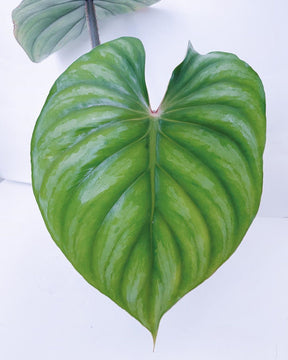Anthurium Clarinervium 101 - Complete Care Guide
 Anthurium Clarinervium: Source
Anthurium Clarinervium: Source
If you are looking for a visually appealing plant to add to your indoor plant collection, look no further than the anthurium clarinervium. Also known as the velvet cardboard anthurium, this plant can trace its roots (see what we did there?) to southern Mexico and is considered a low maintenance plant.
The two Anthuriums are often confused with each other. If you are unsure about which plant you have here are some features to look out for:
- Clarinervium plants have distinguished cordate or heart shaped leaves.
- Berries; crystallinum berries are white to violet in colour.
- Clarinervium has large, orange berries.
If you are eager to learn about anthurium care or want to know more for an upcoming purchase, this guide will break down the basics.
Advantages of Owning a Velvet Cardboard Anthurium
✓ Easy to grow and maintain.
✓ It flowers with relative ease. But be warned-the flowers are rather odd looking!
✓ Striking foliage-it’s heart shaped leaves with white veins make a beautiful display.
Care Guide- The Basics
Most anthurium clarinervium care is straight forward. But if you want this plant to thrive, there are a few keynote tips to ensure your anthurium clarinervium stays happy and healthy.
Lighting
Place your anthurium in a bright spot, with indirect sunlight to promote healthy growth. Try to mimic it’s natural environment with speckled light for best results.
Hot and Humid?
Oh yes! Correct anthurium clarinervium care includes keeping the plant humid, to simulate the temperature of its native Mexico. Try placing the plant in your bathroom, to absorb humidity from your shower. Alternatively, you can mist its leaves a few times per week or keep a humidifier nearby.
Aim to keep the temperature around your anthurium clarinervium between 65 and 73 degrees Fahrenheit for faster growth.
Soil and Water
As a tropical houseplant, the anthurium clarinervium needs a soil that is well-draining and prevents water from building up near the roots.
For optimized health, aim to water your clarinervium twice a week in the growth season (March-September), and a maximum of once a week during winter.
The best soil is a mixture of organic bark, peat and perlite. If this isn’t possible to obtain, this plant can also thrive in a light soil mixed with crushed charcoal, bark chips, mulch or orchid bark. Avoid clay based soils at all costs!
Between March and September, your anthurium clarinervium will need the soil to be kept moist at all times. Check the top inch of the soil before watering to prevent waterlogging and rot. The surrounding humidity will impact on how much water this plant needs.
Toxicity
Be aware that all parts of the anthurium clarinervium are toxic to dogs and cats if ingested. Keep out of reach of children and pets at all times.
Fast Grower
Compared to other members of the anthurium, the anthurium clarinervium is indeed a fast grower in the correct conditions. The leaves can reach 10 inches in length.
Potting, Pruning & Propagation
Aim to place your anthurium clarinervium in a glazed or plastic pot. This will help to retain moisture.
Pruning is straightforward; simply off dead leaves and leggy stems can maximise growth and keeps the clarinervium looking healthy. Aim to do the main pruning in spring before the growing season.
To propagate, you can divide the roots into 2 or 3 sections and place them into separate containers, with appropriate potting soil. Alternatively, you can cut a stem from a new growth. Place the cutting into a small jar of water until new roots begin to form. Transfer into a small pot with a suitable potting mix and voila!
Keep both divided plants and stem cuttings in bright but not direct sunlight.
Common Pests & Problems
The clarinervium is an easy grower, but due to its humidity and potting requirements, it can run into its fair share of issues if not tended to correctly. Here are some of the most common ones!
Mildew on Leaves
- Most Likely Cause: Water accumulation
- Resolution: Cut back on watering and humidity. Spray leaves with a mixture of baking powder and water and wipe mildew off.
Sunburn
- Most Likely Cause: Too much UV light
- Resolution: Cut off sunburnt leaves and move the plant to a more shaded location.
Root Rot
- Most Likely Cause: Overwatering
- Resolution: Propagate healthy roots if possible and dispose of the plant. Use a suitable potting mix that does not cause water logging for the healthy roots!
Remember to keep the soil moist and your clarinervium will truly be a crown jewel in your houseplant collection.
Written byElizabeth O'Brien

















